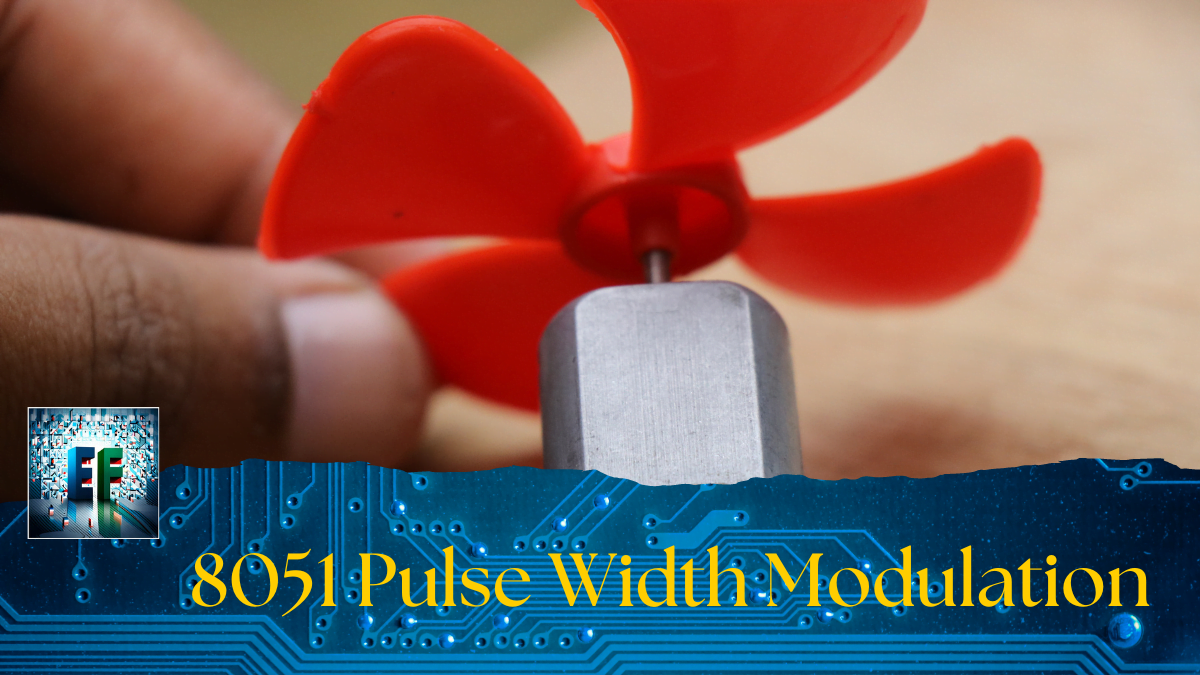Introduction to Pulse Width Modulation with the 8051 Microcontroller
In the realm of motor control, Pulse Width Modulation (PWM) stands as a cornerstone technique, and when combined with the versatile 8051 microcontroller, it opens up a world of possibilities for precise and efficient motor management. We’ll dive deep into the intricacies of implementing PWM using the 8051, exploring its applications in controlling various types of motors, including SC (Series-Compensated) motors, BLDC (Brushless DC) motors, and stepper motors.
Table of Contents
Understanding PWM Basics
Pulse Width Modulation is a powerful method for controlling the amount of power delivered to a load, such as a motor, without incurring the losses associated with linear power control. By rapidly switching a signal between on and off states and varying the duty cycle, we can effectively simulate an analog output with a digital signal.
Key PWM Concepts:
- Duty Cycle: The proportion of ‘on’ time to the total time period
- Frequency: The rate at which the PWM signal completes a cycle
- Resolution: The precision with which we can control the duty cycle
8051 Architecture and PWM Generation
The 8051 microcontroller, with its robust architecture, provides an excellent platform for generating PWM signals. We’ll utilize the timer/counter modules of the 8051 to create precise PWM outputs.
PWM Generation Code Snippet:
#include <reg51.h>
void pwm_init() {
TMOD = 0x01; // Timer 0, mode 1 (16-bit)
TH0 = 0xFF; // Set initial timer value
TL0 = 0x00;
ET0 = 1; // Enable Timer 0 interrupt
EA = 1; // Enable global interrupts
TR0 = 1; // Start Timer 0
}
void pwm_set_duty(unsigned char duty) {
TH0 = 0xFF - duty;
}
void timer0_isr() __interrupt(1) {
P1_0 = !P1_0; // Toggle PWM output pin
TH0 = 0xFF; // Reset timer
}
void main() {
pwm_init();
while(1) {
// Main program loop
pwm_set_duty(128); // 50% duty cycle
}
}
This code sets up Timer 0 to generate a PWM signal on pin P1.0. The duty cycle can be adjusted by calling pwm_set_duty() with a value between 0 and 255.
SC Motor Control with 8051 PWM
Series-Compensated (SC) motors are known for their high starting torque and ability to operate at variable speeds. Implementing PWM control for SC motors using the 8051 allows for precise speed regulation and improved efficiency.
SC Motor Interfacing Circuit
+5V
|
|
+----|----+
| | |
| R |
| | |
+--|----+----|-+
| | | |
| +--[BJT]--+ |
| | |
| | |
[8051] | |
| | |
| [MOTOR] |
| | |
+------+-------+
|
GND
In this circuit, we use a BJT (Bipolar Junction Transistor) as a switch, controlled by the PWM signal from the 8051. This allows us to efficiently regulate the power supplied to the SC motor.
BLDC Motor Control Using 8051 PWM
Brushless DC (BLDC) motors offer high efficiency and reliability. Controlling a BLDC motor with the 8051 requires a more complex setup, typically involving a three-phase inverter circuit.
BLDC Motor Interfacing Circuit
+------------------+
| |
+--+--+ +---+--+
| | | |
[8051] | +-----+ | BLDC |
| +---| ESC |-+ |
| | +-----+ | MOTOR|
| | | |
+-----+ +------+
| |
+------------------+
Here, we use an Electronic Speed Controller (ESC) as an intermediary between the 8051 and the BLDC motor. The ESC interprets the PWM signals from the 8051 and generates the appropriate three-phase signals for the motor.
Stepper Motor Control with 8051 PWM
Stepper motors are ideal for applications requiring precise positioning. By using PWM, we can implement microstepping, which allows for smoother and more accurate control.
Stepper Motor Interfacing Circuit
+5V
|
+--+--+
| |
[8051] | +----------+
| +---| STEPPER |
| | | DRIVER |
| | | +----+ |
| +---| | | |
| | | |MOTOR |
+-----+ | | | |
| | +----+ |
| +----------+
|
GND
In this setup, we use a stepper motor driver IC to interface between the 8051 and the stepper motor. The PWM signals from the 8051 control the step and direction inputs of the driver.
Advanced PWM Techniques for Motor Control
Synchronous Rectification
Synchronous rectification is a technique that can significantly improve the efficiency of motor drives, especially in BLDC and stepper motor applications.
void sync_rect_pwm() {
// Set up Timer 1 for complementary PWM
TMOD |= 0x20; // Timer 1, mode 2 (8-bit auto-reload)
TH1 = 0x00; // Set PWM frequency
TL1 = 0x00;
// Enable interrupts
ET1 = 1;
EA = 1;
// Start Timer 1
TR1 = 1;
}
void timer1_isr() __interrupt(3) {
P1_0 = !P1_0; // Toggle high-side PWM
P1_1 = P1_0; // Complementary low-side PWM
}
This code generates complementary PWM signals, which are crucial for implementing synchronous rectification in motor control applications.
Implementing Closed-Loop Control
To achieve precise motor control, we often need to implement closed-loop systems using feedback from sensors. The 8051’s ADC capabilities can be leveraged for this purpose.
PID Control Algorithm
int error, last_error = 0;
int integral = 0;
int derivative;
int output;
void pid_control(int setpoint, int actual) {
error = setpoint - actual;
integral += error;
derivative = error - last_error;
output = KP * error + KI * integral + KD * derivative;
// Apply output to PWM duty cycle
pwm_set_duty((unsigned char)(output >> 2));
last_error = error;
}
This PID (Proportional-Integral-Derivative) control algorithm can be used to maintain a desired motor speed or position by continuously adjusting the PWM duty cycle based on feedback.
Optimizing PWM for Different Motor Types
SC Motor Optimization
For SC motors, we can implement a soft-start feature to prevent high inrush currents:
void sc_motor_soft_start() {
unsigned char duty;
for(duty = 0; duty < 255; duty++) {
pwm_set_duty(duty);
delay_ms(10); // Gradual increase over ~2.5 seconds
}
}
BLDC Motor Commutation
BLDC motors require precise timing for commutation. We can use the 8051’s timers to generate the appropriate sequence:
const unsigned char commutation_sequence[] = {
0b101, 0b100, 0b110, 0b010, 0b011, 0b001
};
void bldc_commutate(unsigned char step) {
P1 = (P1 & 0xF8) | commutation_sequence[step];
}
Microstepping for Stepper Motors
Implementing microstepping can significantly improve the smoothness of stepper motor operation:
const unsigned char sine_table[32] = {
128, 153, 177, 199, 218, 234, 246, 254,
// ... (remaining values omitted for brevity)
};
void microstep(unsigned char step) {
unsigned char coil_a = sine_table[step & 0x1F];
unsigned char coil_b = sine_table[(step + 8) & 0x1F];
pwm_set_duty_a(coil_a);
pwm_set_duty_b(coil_b);
}
Energy Efficiency Considerations
Implementing energy-efficient motor control is crucial for battery-powered applications and reducing overall power consumption.
Sleep Mode Integration
We can utilize the 8051’s power-saving features to reduce energy consumption during motor idle periods:
void enter_sleep_mode() {
PCON |= 0x01; // Set IDL bit to enter Idle mode
// CPU will wake up on the next interrupt
}
Dynamic PWM Frequency Adjustment
Adjusting the PWM frequency based on the motor’s operating conditions can optimize efficiency:
void adjust_pwm_frequency(unsigned int rpm) {
if(rpm < 1000) {
TH0 = 0xFC; // Set for lower frequency
} else {
TH0 = 0xFF; // Set for higher frequency
}
}
Conclusion
Mastering Pulse Width Modulation with the 8051 microcontroller opens up a world of possibilities in motor control applications. From basic speed control to advanced techniques like synchronous rectification and closed-loop systems, the combination of PWM and the 8051 provides a powerful toolset for engineers and hobbyists alike.
By understanding the unique characteristics of SC motors, BLDC motors, and stepper motors, and implementing tailored PWM strategies for each, we can achieve optimal performance and efficiency in a wide range of motor control scenarios. The code snippets and circuit diagrams provided serve as a starting point for your own motor control projects, offering insights into the practical implementation of these concepts.
As we continue to push the boundaries of motor control technology, the fundamental principles of PWM and the versatility of the 8051 microcontroller remain invaluable tools in our arsenal. Whether you’re developing cutting-edge industrial automation systems or working on a DIY robotics project, the knowledge and techniques discussed here will undoubtedly prove useful in your endeavors.
Remember, effective motor control is not just about raw power, but about precision, efficiency, and adaptability. By mastering PWM with the 8051, you’re well-equipped to tackle a wide array of motor control challenges, innovate new solutions, and drive the future of electromechanical systems.







